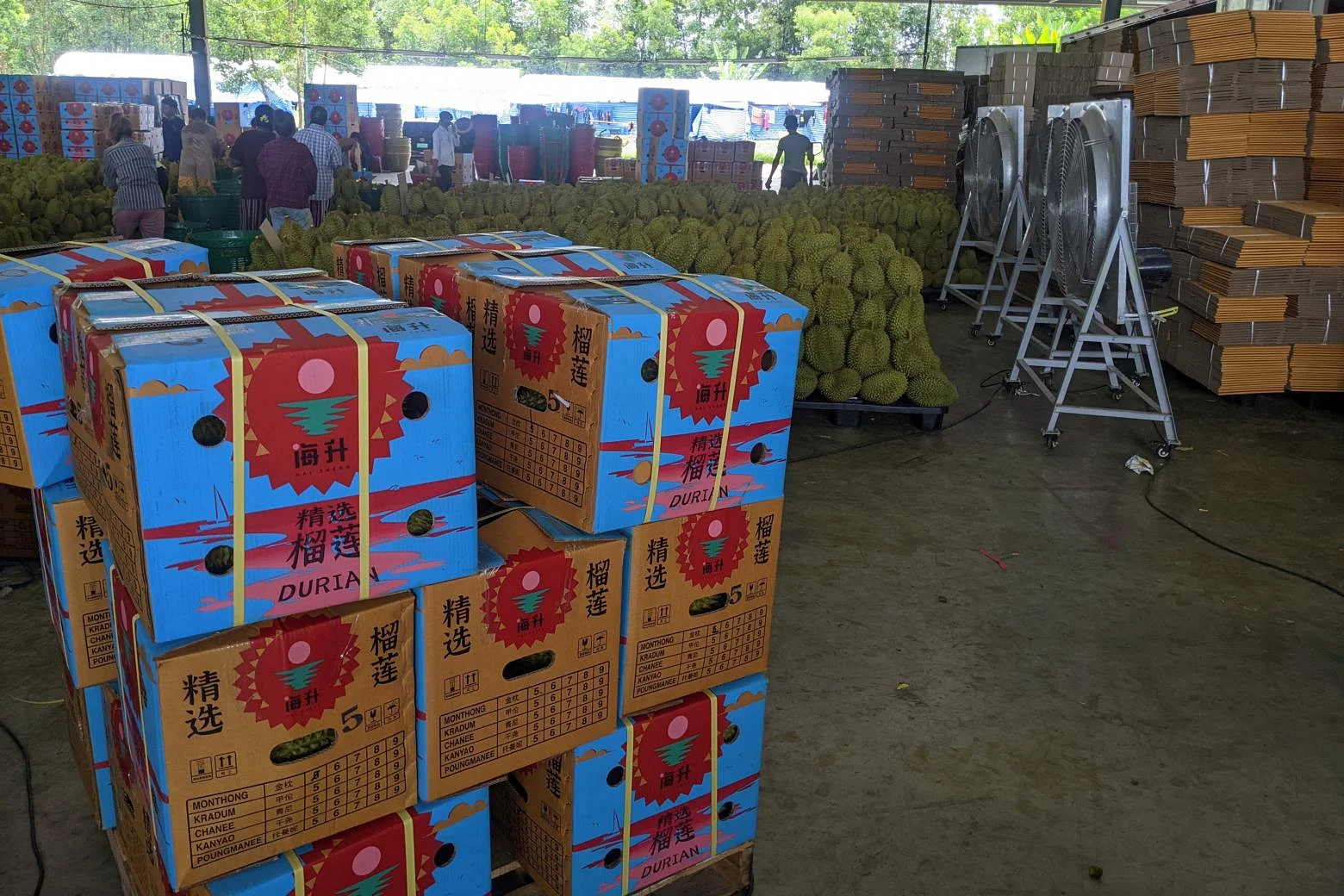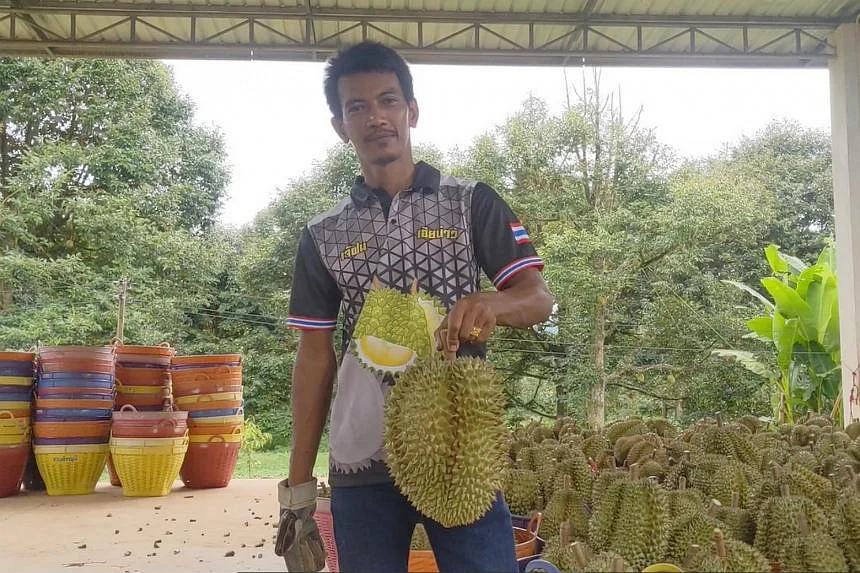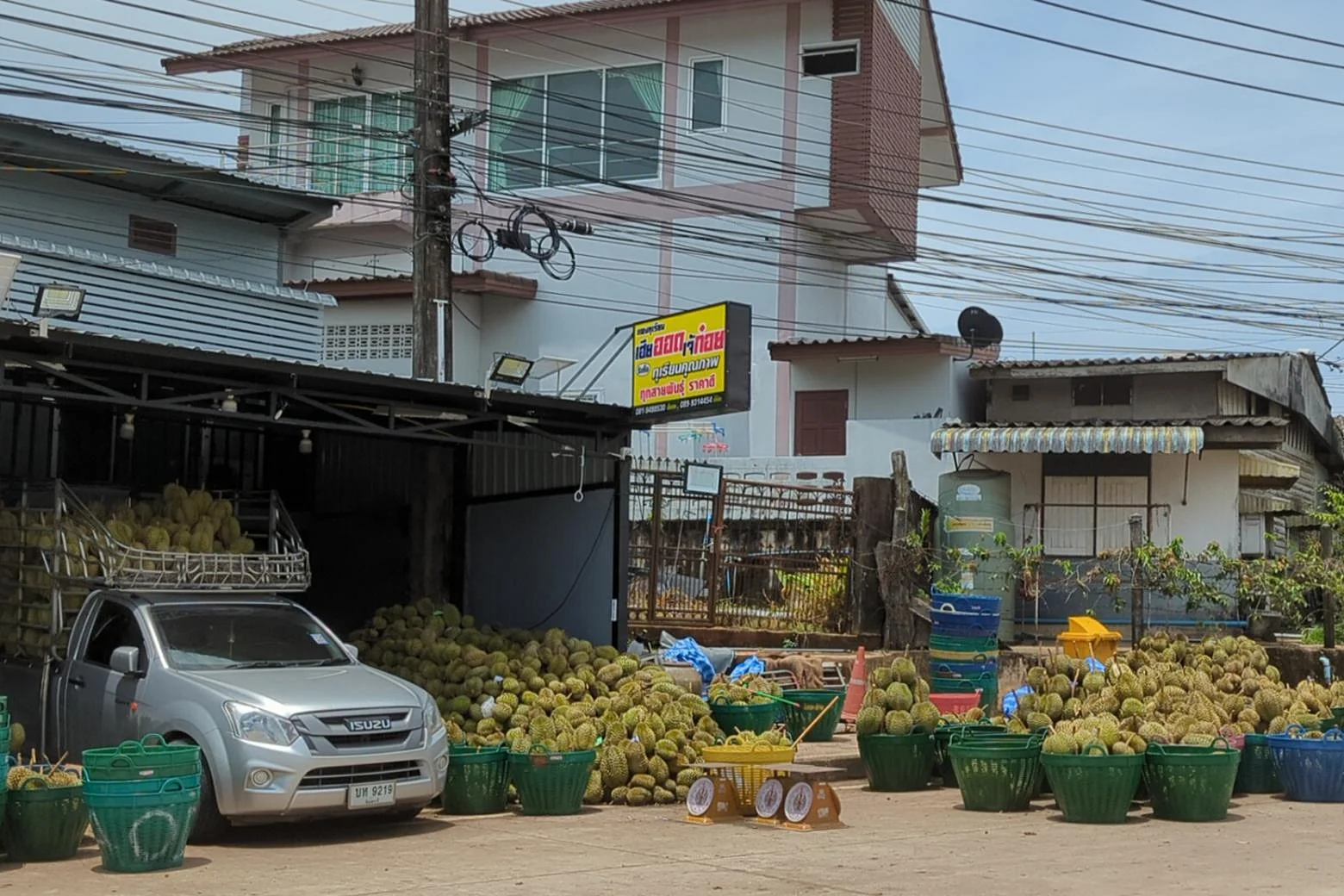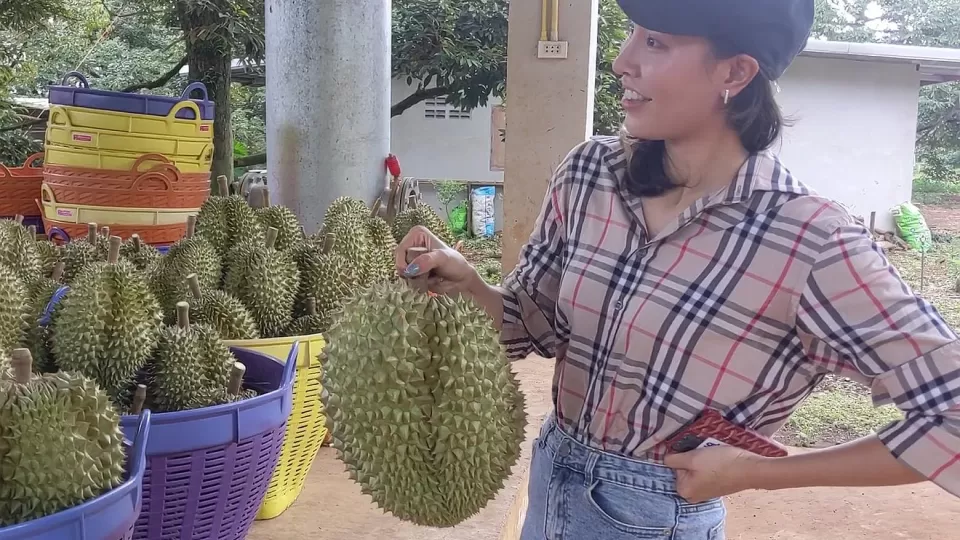June 13, 2022
SINGAPORE– It literally rains durian this time of year at the Petmunee Orchard in Chanthaburi as workers collect the spoils of harvest – one man flinging the weighty fruit from his perch amid the canopy of a 15m high tree, his partner below deftly catching the thorny-shelled projectile with a gunny sack.
Workers have been busy harvesting the king of fruits from the 32ha orchard in the north-eastern Thai province as the durian season reaches its peak in May and June.
Ms Tucksymone Petmunee, 29, said the orchard is expected to yield some 200 tonnes of the monthong variety of durian this season.
“Business has been getting better each year. But will this last? Honestly, I don’t think so,” said Ms Tucksymone, who oversees one of two family-owned durian orchards.
Appetite for Thai durians has spiked even through the Covid-19 pandemic, earning Thailand the title of top durian exporter in the world. But some are wary of a “durian bubble”.
Up to 90 per cent of Thailand’s durian produce is exported to China, which welcomed more than 875,000 tonnes of the fruit worth 109.2 billion baht (S$4.4 billion) last year. This export stream is expected to grow 9.8 per cent this year to reach a value of 120 billion baht, said Thailand’s Ministry of Agriculture and Cooperatives.
Some durian farms in Thailand export exclusively to China, with hardly any of their fruit entering the much smaller domestic market.

Up to 90 per cent of Thailand’s durian are exported to China and appetite for the fruit has only grown in the last few years, even during the pandemic. ST PHOTO: TAN TAM MEI
However, the usual bountiful exports hit a snag in recent months, as China’s strict zero-Covid policy and import inspections locked containers of Thai durians out of China.
Industry players and observers have also begun to question the sustainability of an industry that hinges so heavily on Chinese demand.
“With harvest season happening only once a year, durian farmers have a lot to lose if demand for durian exports falls,” said Ms Patchaya Khiaophan, vice-president of marketing for the Thai Durian Association (TDA), who is also a durian farmer.
Most farms focus on growing the monthong breed, also known as “golden pillow”, as this is the most popular variety in China.
It is also the most “beginner-friendly” durian, as the variety is known to be sweet and creamy, and has small seeds, said farmer Nutchanok Kitchagarn, 33.

Most durian farms in Chanthaburi focus on growing the monthong breed of durian, which is known to be sweet and creamy, and has small seeds. ST PHOTO: TAN TAM MEI

Monthong durians, especially the bigger ones like this 5kg durian, are mostly exported overseas to China. ST PHOTO: TAN TAM MEI
Like many others, her family farm Baan Suan Ratchanat is in Chanthaburi, which is one of Thailand’s key fruit provinces, like Rayong and Trat. In these north-eastern provinces, durian season is typically during the months of April to June.
The larger north-eastern region accounts for about half of Thailand’s total fruit production.
With durian wholesale prices averaging about 140 baht per kg this season, hitting 200 baht at one point, the fruit has proven to be a “golden” cash crop for Thailand, and numerous players have been clamouring to get some skin in the game.
Across Thailand, durian farmland has spiked from just 96,000ha in 2012 to 152,000ha in 2019, according to the Office of Agricultural Economics.
The agriculture authorities have forecast the production of 1.4 million tonnes of durian this year, up 17 per cent from the previous year.
Driven by durians’ strong export demand and high returns, almost 80 per cent of farmers in Chanthaburi have changed from planting rubber trees to durian plants, said environmentalist Somnuck Jongmeewasin, noting a similar trend in other major crop industries like cassava.
“I do think there is the risk of a durian bubble,” said Dr Somnuck, who is also research director of the Eastern Economic Corridor Watch, an advocacy group.

Durian season for Chanthaburi is around April to June every year, and durian can be seen everywhere along the roadside. The area, which is also known as the fruit province of Thailand, also produces mangosteen and longans. ST PHOTO: TAN TAM MEI
While demand prevails, exporting fresh durian to China via the land routes through Laos and Vietnam and to Chinese sea ports has proven challenging with strict import screening to prevent Covid-19 spread.
“They’re not just testing the workers, they’re also swabbing the durian and all surfaces,” said Ms Patchaya, adding that the worldwide shortage of freight containers has also affected exporters.
If the virus is found, the batch of fruit is rejected or destroyed, and the border is temporarily closed.
The Thai authorities have cautioned durian exporters and farmers to be vigilant in ensuring their shipments meet sanitary and quality control standards.
But with many hands involved in the movement of the fruit, exporters said it can be hard to pass the rigorous checks, and the result has been costly.
Exporter Tai Yang Shen said it lost some two million baht in April when the virus was detected onboard the ship used for one of its durian shipments.
“We did try to see if we could sanitise the shipment again so it could enter the port, but it took too long,” said a spokesman for the firm, adding that the fruit had to be discarded.
Additional virus checks and paperwork have no doubt also increased customs processing time, which adds to the risk of the perishable fruit rotting.
“We lost a batch of durian when a typically five-day journey (using land checkpoints) became a 1½-month wait at the border,” said Ms Ananya Amornjaturaporn, 29, the manager of exporter Yuan Cheng Fresh.
Her firm now primarily transports the durians via sea, which takes seven days but is a more reliable route, said Ms Ananya.
Her export centre in Chanthaburi typically processes about 30 tonnes of durian a day.
The durians are picked when they are about 60 per cent to 70 per cent ripe, and are treated with a turmeric solution to preserve the quality and appearance of the fruit.
They are then packed into refrigerated trucks for the journey.
The new China-Laos railway is being touted as a solution to these Covid-19 export issues, after it was opened in December last year.
Since March, Thailand has sent at least two batches of fruit, including 425 tonnes of durian, to China via these electric bullet trains.
The TDA is certain the railway will become one of the main export routes in the future, but there are still several teething issues, said Ms Patchaya.
“We will need air-conditioned containers and cranes to transfer the containers from local trains to the railway. This might mean higher costs,” she said.
The Thai government has made considerable efforts to promote and negotiate for durian and fruit exports overseas.
Thailand has also invested significant resources in specialised research and laboratories to ensure a sustainable agricultural sector.
Agriculture and Cooperatives Minister Chalermchai Sri-on last month urged growers to increase cultivation of quality durian, adding that there would be no oversupply problem over the next decade, reported The Nation.
Selling high grade fruit is the only way to maintain Thailand’s competitive advantage, concurred international trade expert Punpreecha Bhuthong, a senior researcher at the Thailand Development Research Institute.
“We depend so much on one big market, so the worry is that one day China might not buy as much of our durian,” said Mr Punpreecha.

Up to 90 per cent of Thailand’s durian are exported to China and appetite for the fruit has only grown in the last few years, even during the pandemic. ST PHOTO: TAN TAM MEI
This risk, coupled with Vietnam and Cambodia trying to make inroads to export their home-grown durians to China, could drive prices down, he added.
Ms Patchaya said the growing number of durian farmers and operators in the industry and the increasing agricultural and labour costs are unsustainable.
“Many farmers have invested everything into growing durian. If the prices drop drastically, they will lose everything,” she said, adding that this could happen in the next five to 10 years if the issues persist.
The association has been trying to help growers find ways to reduce production cost using farming technology and aims to find new export markets for the fruit.
Currently, a small percentage of Thai durians are exported to other countries like South Korea, the United States and Japan. The Thai authorities also want to expand fruit exports to new markets in the Middle East.
But Mr Punpreecha said this could be difficult given the “uniqueness” of the divisive fruit.
“If you like it, you love it. If you don’t, you’ll hate it. So it’s not that easy to diversify to other markets.”
In any case, he added, new markets “cannot compare to the market size of China”.


